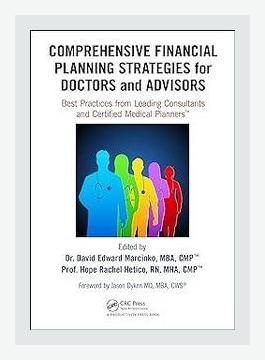Finance and AccountingFinancial Planning
Title: Comprehensive Financial Planning Strategies for Doctors and Advisors
Author: David Edward Marcinko
Publication Year: 2015
Category: Financial Planning
Introduction
“Comprehensive Financial Planning Strategies for Doctors and Advisors” by David Edward Marcinko is an insightful guide tailored to the unique financial planning needs of medical professionals. This comprehensive manual covers a wide spectrum of strategies, addressing the distinct economic challenges and opportunities doctors face. The book’s structured approach encapsulates financial management, risk mitigation, investment strategies, tax planning, retirement, and estate considerations. This summary highlights the key takeaways and actionable advice from the book.
Chapter 1: Understanding Physicians’ Financial Landscape
Key Points:
– Income Volatility: Physicians often face income fluctuations based on their specialization, geographic location, and changes in healthcare policies.
– Financial Education Deficit: Despite high earnings, many doctors lack formal financial education, which can lead to mismanagement of funds.
Actionable Advice:
– Conduct a Self-Assessment: Evaluate personal income flow, expenditures, and savings rate.
– Pursue Financial Education: Enroll in finance-related courses or seek mentorship from financial advisors skilled in handling medical professionals’ finances.
Chapter 2: Establishing a Financial Plan
Key Points:
– Goal Setting: Physicians should outline short-term and long-term financial goals, considering their career stages.
– Budgeting: Create a detailed budget that covers fixed costs, variable expenses, and savings.
Concrete Example:
– A young physician may prioritize paying off medical school debt within ten years while saving for a down payment on a house.
Actionable Advice:
– Utilize Financial Software: Use budgeting applications like Mint or YNAB to track expenses and savings automatically.
– Regular Reviews: Schedule quarterly financial reviews to reassess goals and adjust the budget as necessary.
Chapter 3: Debt Management and Reduction
Key Points:
– Student Loans: Develop a strategy for repaying medical school loans, considering options like consolidation vs. aggressive repayment.
– Credit Card Debt: Avoid high-interest credit card debt by controlling discretionary spending.
Concrete Example:
– A resident might opt for income-driven repayment plans during residency and shift to standard repayment plans once they transition to a higher income bracket.
Actionable Advice:
– Refinance Student Loans: If possible, refinance high-interest loans to take advantage of lower rates.
– Avoid Unnecessary Debt: Utilize cash flow for smaller purchases and reserve credit for substantial or emergency expenses only.
Chapter 4: Investment Strategies for Physicians
Key Points:
– Diversification: Physicians should diversify their investment portfolios to mitigate risk.
– Retirement Accounts: Maximize contributions to retirement accounts like 401(k), IRA, and Roth IRA.
Concrete Example:
– A doctor might allocate a portion of their portfolio to stocks, bonds, real estate, and mutual funds.
Actionable Advice:
– Hire an Investment Advisor: Collaborate with advisors specializing in medical professionals to create a personalized investment strategy.
– Regular Portfolio Assessment: Annually review and rebalance portfolios to stay aligned with financial goals and risk tolerance.
Chapter 5: Risk Management and Insurance
Key Points:
– Malpractice Insurance: Necessity for all medical practitioners to protect against legal liabilities.
– Disability Insurance: Critical to safeguard income in case of injury or illness that prevents practicing.
Concrete Example:
– A surgeon should have comprehensive disability insurance coverage that includes both short-term and long-term options.
Actionable Advice:
– Regular Policy Reviews: At least annually, review and update insurance policies to ensure adequate coverage.
– Shop for Competitive Rates: Regularly compare insurance rates and policy terms to find the best deals.
Chapter 6: Tax Planning
Key Points:
– Tax-Advantaged Accounts: Utilize HSAs, FSAs, and retirement accounts for tax savings.
– Deductions and Credits: Identify all possible deductions relevant to medical professionals.
Concrete Example:
– Expenses related to continuing education, medical equipment, and professional memberships can often be deductible.
Actionable Advice:
– Consult a Tax Professional: Work with a CPA who understands medical taxation nuances to optimize tax returns.
– Keep Detailed Records: Maintain meticulous records of all potential tax-deductible expenses throughout the year.
Chapter 7: Retirement Planning
Key Points:
– Early Planning: Start retirement planning early in one’s career to leverage compound interest.
– Defined Benefit Plans: Consider employer-sponsored defined benefit plans for stable post-retirement income.
Concrete Example:
– A physician could start contributing to a Roth IRA during residency to take advantage of lower current tax rates.
Actionable Advice:
– Calculate Retirement Needs: Use retirement calculators to estimate how much money will be needed based on lifestyle and expected longevity.
– Incremental Increases: Gradually increase retirement contributions annually to boost savings without significant lifestyle impacts.
Chapter 8: Estate Planning
Key Points:
– Wills and Trusts: Essential for ensuring assets are distributed according to one’s wishes.
– Beneficiary Designations: Critical on retirement accounts and insurance policies for smooth transfer of assets.
Concrete Example:
– A doctor with a significant estate might establish a trust to manage and distribute assets to heirs in a tax-efficient manner.
Actionable Advice:
– Hire an Estate Attorney: Work with legal professionals to create a comprehensive estate plan.
– Regular Updates: Periodically review and update estate planning documents to reflect life changes such as marriage, divorce, and childbirth.
Conclusion
“Comprehensive Financial Planning Strategies for Doctors and Advisors” by David Edward Marcinko offers invaluable guidance for medical professionals aiming to achieve financial stability and growth. By addressing the unique financial challenges faced by doctors, the book provides actionable insights and practical strategies to manage income fluctuations, optimize investments, mitigate risks, and plan for a secure future. Through robust financial planning and proactive steps, physicians can ensure their financial health complements their professional success.
